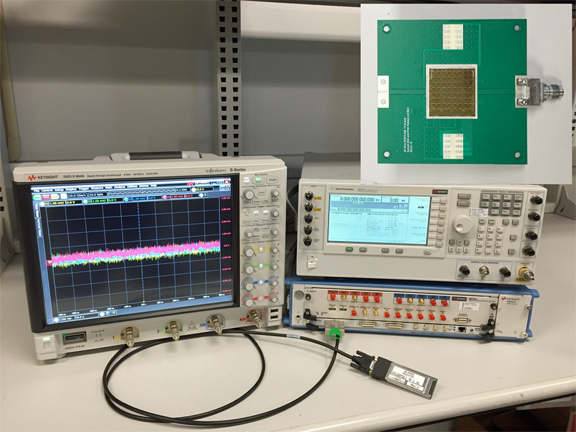[Satnews] Keysight Technologies, Inc. (NYSE: KEYS), in collaboration with The University of California, San Diego (UCSD), has demonstrated the world’s first 64 (8 x 8) and 256-element (16 x 16), 60-GHz silicon wafer-scale phased-array transmitter with integrated high-efficiency antennas for Gbps communications at 100 to 200 meters.
With this demonstration, Keysight and UCSD have now proven that a 5G communication link is not only possible, but can deliver record performance. Keysight’s collaboration with UCSD builds on an earlier effort between the university and TowerJazz, which resulted in development of the industry’s first 64- and 256-element system-on-a chip (SoC) phased arrays operating at 60 GHz. Each wafer-scale SoC comprises a 60 GHz source, amplifiers, distribution network, phase shifters, voltage controlled amplifiers and high-efficiency on-chip antennas. The chips were designed to meet the needs of 5G high-performance Gbps data-rate communication systems with beamforming capabilities and for Aerospace & Defense systems.

Shown here is the Keysight equipment used for the 60-GHz 802.11ad and 5G link measurements with the UCSD 64-element wafer-scale phased array, including the M8190A arbitrary waveform generator, E8267D PSG vector signal generator and the DSOS804A Infiniium S-Series high-definition oscilloscope.
Photo is courtesy of Keysight Technologies.
Following the development of the phased-array SoCs, Keysight and UCSD set out to prove they could be used in a communications link. All work was sponsored by the Defense Advanced Research Projects Agency (DARPA) and Keysight. To develop that link, UCSD relied on a powerful suite of Keysight instruments that included the M8190A arbitrary waveform generator, E8267D PSG vector signal generator and the DSOS804A Infiniium S-Series high-definition oscilloscope with 10-bit ADC. For local oscillator generation, the Keysight E8257D PSG analog signal generator was employed.
The 60-GHz 802.11ad waveform UCSD required for the development effort was generated using Keysight’s Signal Studio software and analyzed using its 89600 VSA software. Keysight’s 81199A Wideband Waveform Center software also proved valuable, helping UCSD link transmit and receive, apply digital pre-distortion and improve error-vector-magnitude.
All Keysight instrumentation and software used in the development of the 5G communication link is available now. The phased-array SoCs are also now available.
Executive Comments
“UCSD, a world leader in low-cost SiGe and CMOS phased-arrays, has demonstrated several phased-array systems operating in the 6- to 100-GHz range and developed the first affordable wafer-scale 64- and 256-element phased-array transmitter for 5G communications,” said Gabriel M. Rebeiz, distinguished professor and wireless communications industry chair at UCSD.
“The Keysight suite of equipment and software, with its ease of use and technical support, proved essential to enabling the rapid demonstration of the 100-200 meter 802.11ad and 5G link and allowing our phased-array to scan +/-45 degrees in all planes,” said Dr. Samet Zihir, post-doctoral fellow at UCSD. “We are very happy to have partnered with Keysight on this project, and we look forward to using this equipment and software suite on networked 5G systems.”
“Keysight is actively involved in 5G standards development and is fully committed to innovating the solutions needed to accelerate deployment of the next generation of wireless communications,” said Mark Pierpont, vice president and general manager Keysight’s Communications Measurement Solutions. “That’s why we are so proud to have collaborated with UCSD on the 5G communication link. It not only represents a significant advance in the realization of 5G, but also paves the way for future research and development of millimeter-wave communication systems.”



